Articles
Maximize The Stability & Security of Your Snatch Overhead Position
December 26 2016
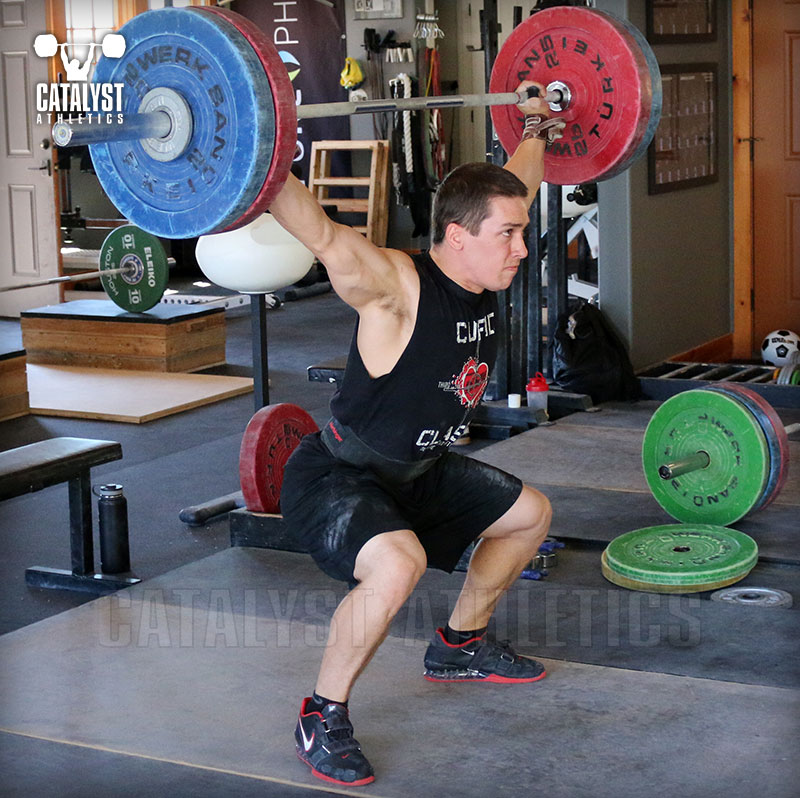
December 26 2016

This is a subject near and dear to my heart… which is black with rage in reaction to all the incredibly bad advice out there. Of course I’m joking—how you hold a bar over your head is your business, but my business is helping you do it the best way possible, so let’s team up and make your dreams come true.
There are a few simple things the snatch overhead position needs to accomplish:
Bar & Head
The barbell should be positioned vertically over the base of the neck, i.e. where your neck and traps meet, with the head pushed forward through the arms a bit (not to an extreme degree and not tilted down significantly), and the trunk should be inclined forward very slightly. With the correct overhead position, you should be able to lower the bar in a vertical line to the top of your traps and press it straight back up into the correct position without any part of your body moving but your arms.
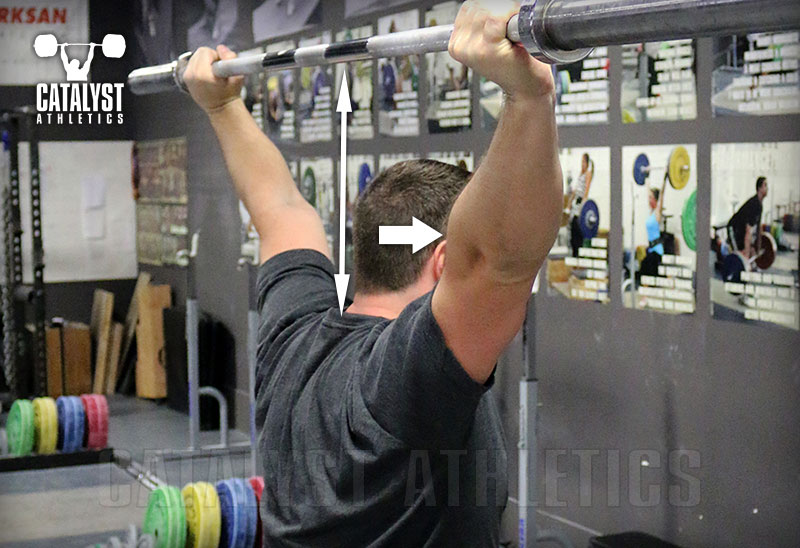
The bar should be over the base of the neck with the head pushed forward slightly.
Grip Width
First of all, you can’t have a solid overhead position if your grip width is problematic—you’re setting yourself up for failure. My starting point for determining grip width in the snatch is simple—with the bar hanging at arms’ length, it should rest in the crease of the hips.
From this starting point, adjustments can be made to accommodate unusual proportions, i.e. short torso and long legs/arms. For proportions significantly outside the norm, the bar may not be able to contact in the crease of the hip.
Excessive grip width is less stable overhead, with more tendency for the lifter to miss snatches behind, harder on the wrists and elbows, and limits how well the shoulders can be locked into place, while too narrow a grip can limit mobility overhead and prevent secure locking of the elbows and shoulders.
Upper Back
The T-spine should be extended (i.e. flattened) and locked into place along with the rest of the trunk through pressurization and muscular effort. Forward rounding of the upper back is already placing the shoulders in a compromised position and preventing security for the arms.
Shoulders
The shoulder blades should be retracted and somewhat upwardly rotated—not shrugged up, although it will appear they’re shrugged slightly in the correct position. The easiest way to achieve this position is to simply squeeze the upper inside edges of the shoulder blades together forcefully—this will create the retraction and upward rotation we want. This should be an active, forceful position—this is your base, and without its security and stability, the rest of the position can’t be stable.
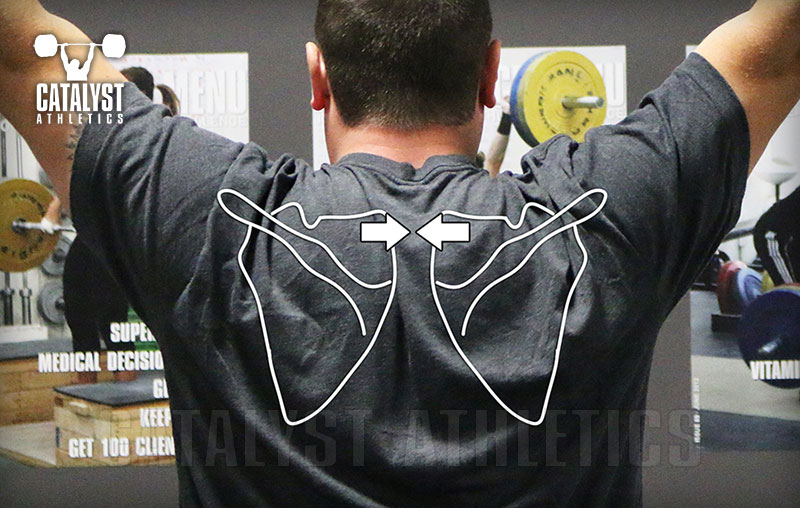
The shoulder blades should be retracted and upwardly rotated - squeeze the upper inside edges together forcefully.
Elbows & Arm Rotation
The elbows need to be completely extended, and aggressively. Not mostly extended, not kind of extended… extended. If you have an issue with hyperextension, you need to strengthen your arms to support the elbow better.
Internal vs. external rotation of the arms overhead is a point of contention lately online, but there really isn’t any ambiguity in practice—the arms should be about neutral in terms of IR/ER, i.e. about midway between complete internal and complete external rotation. The simple way to create this position and/or visualize it is to orient the bony point of the elbow about halfway between straight down toward the floor and straight back. Remember, the precise degree of rotation will vary slightly among lifters, but never should it be extreme in either direction.
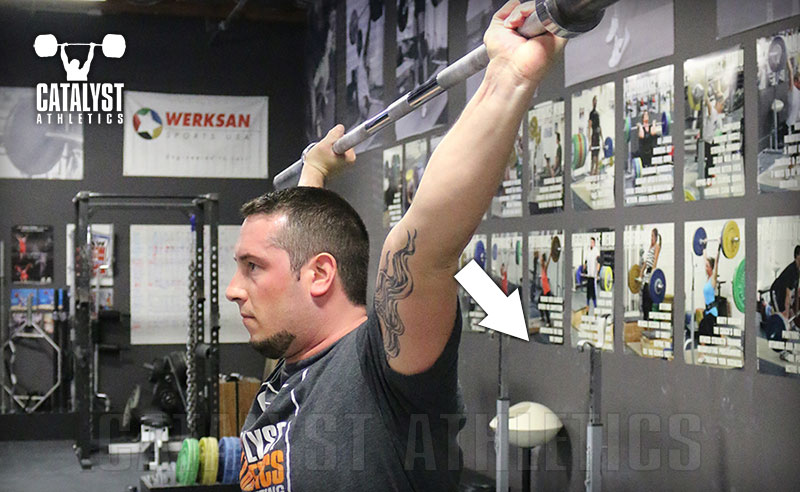
The arms should be neutral in terms of internal/external rotation - the bony points of the elbows oriented about halfway between straight down and straight back.
Hands & Wrists
The bar should be in the palms with the wrist partially extended so that the heel of the palm is facing upward more than forward, with the bar positioned over the forearm slightly behind its midline. Think of this position like the cradle of a squat rack.
The grip should only be as tight as necessary to maintain control of the bar and preserve the correct hand and wrist position. Excessive grip tension will limit the speed of elbow extension and also the ultimate degree of extension.
The hook grip should only be used overhead if you’re able to achieve the proper position with it—if not, you need to learn to release the hook in the turnover of the snatch.
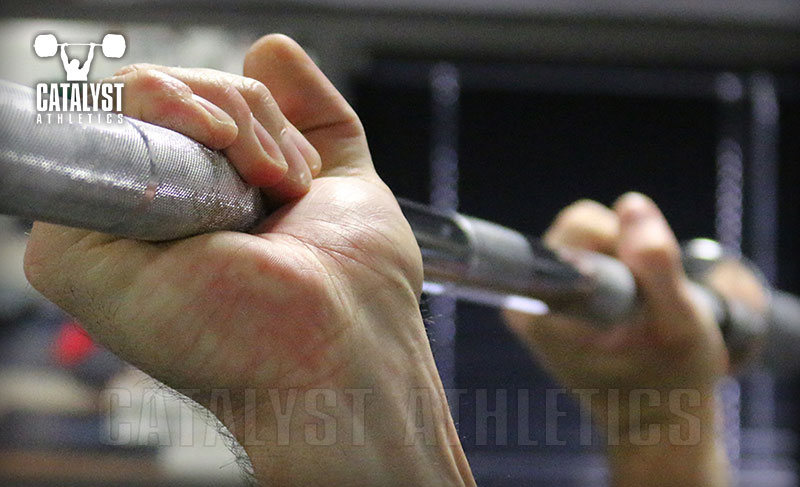
The wrists should be somewhat extended to direct the heel of the palm more upward than forward, the bar slightly behind the midline of the forearm, and the grip only as tight as needed for control.
Practice
When achieving or holding the overhead position, always rely on the upper back and shoulder blades as your foundation. Lock the shoulder blades in place forcefully to create a stable base from which the arms can extend securely. Extend the elbows completely and reach the palms up through the bar—don’t choke it to death.
Practice and refine this position with every single overhead rep you do—the more you practice it, the sooner it will become second nature and give you that stable, consistent overhead position you’ve always wanted. If you’re lazy on your warm-up reps, guess what—your overhead position will suffer because the majority of your volume is being done with a suboptimal, sloppy overhead position. This isn’t complicated, it just takes work.
There are a few simple things the snatch overhead position needs to accomplish:
- Stability (wrists, elbows and shoulders)
- Comfort (i.e. it’s painless)
- Balance (of the bar over the body and of the body-bar complex as a whole)
Bar & Head
The barbell should be positioned vertically over the base of the neck, i.e. where your neck and traps meet, with the head pushed forward through the arms a bit (not to an extreme degree and not tilted down significantly), and the trunk should be inclined forward very slightly. With the correct overhead position, you should be able to lower the bar in a vertical line to the top of your traps and press it straight back up into the correct position without any part of your body moving but your arms.

The bar should be over the base of the neck with the head pushed forward slightly.
Grip Width
First of all, you can’t have a solid overhead position if your grip width is problematic—you’re setting yourself up for failure. My starting point for determining grip width in the snatch is simple—with the bar hanging at arms’ length, it should rest in the crease of the hips.
From this starting point, adjustments can be made to accommodate unusual proportions, i.e. short torso and long legs/arms. For proportions significantly outside the norm, the bar may not be able to contact in the crease of the hip.
Excessive grip width is less stable overhead, with more tendency for the lifter to miss snatches behind, harder on the wrists and elbows, and limits how well the shoulders can be locked into place, while too narrow a grip can limit mobility overhead and prevent secure locking of the elbows and shoulders.
Upper Back
The T-spine should be extended (i.e. flattened) and locked into place along with the rest of the trunk through pressurization and muscular effort. Forward rounding of the upper back is already placing the shoulders in a compromised position and preventing security for the arms.
Shoulders
The shoulder blades should be retracted and somewhat upwardly rotated—not shrugged up, although it will appear they’re shrugged slightly in the correct position. The easiest way to achieve this position is to simply squeeze the upper inside edges of the shoulder blades together forcefully—this will create the retraction and upward rotation we want. This should be an active, forceful position—this is your base, and without its security and stability, the rest of the position can’t be stable.

The shoulder blades should be retracted and upwardly rotated - squeeze the upper inside edges together forcefully.
Elbows & Arm Rotation
The elbows need to be completely extended, and aggressively. Not mostly extended, not kind of extended… extended. If you have an issue with hyperextension, you need to strengthen your arms to support the elbow better.
Internal vs. external rotation of the arms overhead is a point of contention lately online, but there really isn’t any ambiguity in practice—the arms should be about neutral in terms of IR/ER, i.e. about midway between complete internal and complete external rotation. The simple way to create this position and/or visualize it is to orient the bony point of the elbow about halfway between straight down toward the floor and straight back. Remember, the precise degree of rotation will vary slightly among lifters, but never should it be extreme in either direction.

The arms should be neutral in terms of internal/external rotation - the bony points of the elbows oriented about halfway between straight down and straight back.
Hands & Wrists
The bar should be in the palms with the wrist partially extended so that the heel of the palm is facing upward more than forward, with the bar positioned over the forearm slightly behind its midline. Think of this position like the cradle of a squat rack.
The grip should only be as tight as necessary to maintain control of the bar and preserve the correct hand and wrist position. Excessive grip tension will limit the speed of elbow extension and also the ultimate degree of extension.
The hook grip should only be used overhead if you’re able to achieve the proper position with it—if not, you need to learn to release the hook in the turnover of the snatch.

The wrists should be somewhat extended to direct the heel of the palm more upward than forward, the bar slightly behind the midline of the forearm, and the grip only as tight as needed for control.
Practice
When achieving or holding the overhead position, always rely on the upper back and shoulder blades as your foundation. Lock the shoulder blades in place forcefully to create a stable base from which the arms can extend securely. Extend the elbows completely and reach the palms up through the bar—don’t choke it to death.
Practice and refine this position with every single overhead rep you do—the more you practice it, the sooner it will become second nature and give you that stable, consistent overhead position you’ve always wanted. If you’re lazy on your warm-up reps, guess what—your overhead position will suffer because the majority of your volume is being done with a suboptimal, sloppy overhead position. This isn’t complicated, it just takes work.

Greg Everett
I'm a beginner (~70kg BW, 60kg snatch) and I've been struggling with my snatch overhead position since the beginning (about half year ago). Pretty much after every snatch session, I would get what the physio diagnosed as shoulder impingement. It is of course very frustrating and not manageable in the long-term.
I've been coached several times by a good lifter who suggested me to try to pull the bar apart, although that doesn't seem to work for me. I believe that my arms are neutral but I'm not sure that I properly perform what you describe for the shoulder blades.
Would you have any suggestion on how to prevent impingement in the snatch or on any assistance exercise that might help that? Are the shoulder blades locking and rotation the key for that? Is that also what transfers the weight from the front of the shoulders to the traps?
Thank you so much for your help.
Dario
Greg Everett
Most importantly, as the opening of the article says clearly - how you want to hold a bar overhead is your business. If you believe significant IR overhead is going to help you snatch more, knock yourself out.
Greg Everett
I'm not sure what you're basing your assessment of their technique on.
Here's a video where Torokhtiy talks about the arm position overhead in the snatch: https://youtu.be/xZBehiZhfGM?t=244
In just a couple of minutes, he very clearly demonstrates and emphasizes internal rotation and explains how it makes it possible to hold more weight using less muscular strength, and how it's more correct. He even contrasts it with more external rotation, showing the "wrong" technique.
Here is the video of Ilya in his seminar: https://youtu.be/PGdrq7FonYc?t=172
He very clearly shows the same thing, noting the impact on the joints. Through the interpreter, he performs external rotation, saying "this is bad", and then internal, saying "this is good." Then, he talks about how to turn the sholders on and point the elbows back.
Note that this is not a case of elite lifters talking about their personal approach, or worse, a simple observation of and elite lifter's technique in competition. Instead, these are clearly world class athletes (with a lot of unique knowledge) who are communicating to an audience that is assumed to be novice and which is looking to learn how to do the movements correctly.
Obviously, people have different bodies and the degree of internal rotation will vary. But, it's unambiguous (at least according to these guys): internal rotation is correct.
Ilin / Torokhtiy
Neither is internally rotating his arms dramatically. Torokhtiy has internally rotated more over time, but in his competitive prime was nearer neutral. You can look across the range of elite lifters and you will find on average a position around neutral. There will always be outliers, and outliers are always the wrong ones to model. Again, as stated clearly in the article, there will be a range accounting for anatomical variation, but neither dramatic internal nor external rotation is going to be ideal, even though in cases of mobility restrictions, internal rotation may be the only way certain lifters can hold a bar overhead initially.
As I said at the outset... you can hold the bar overhead however you want, but to claim that elite lifters internally rotate their arms is simply untrue. They can say whatever they want in their seminars, but I'm more interested in what actually worked for them as athletes, and more importantly, what more than two athletes are doing. Plenty of of lifters get weird ideas in their heads late in their careers or afterward and have no way to evaluate them because they're not lifting at their best any longer.
Greg Everett
Greg Everett
I have really uneven mobility in my shoulders when doing snatches where my left shoulder is way more restricted and in front compare to my right shoulder.
When I do an overhead squat I can generally squat pretty comfortably and evenly, but whenever I snatch my upper body start twisting to the right which causes me to lose my stability when I am at the bottom of the snatch.
Any recommendation on how to fix this problem?